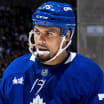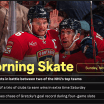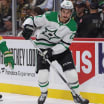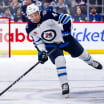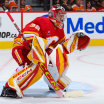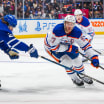Mailbag: Kraken growth in second season; Devils playoff chances
NHL.com's Dan Rosen answers weekly questions
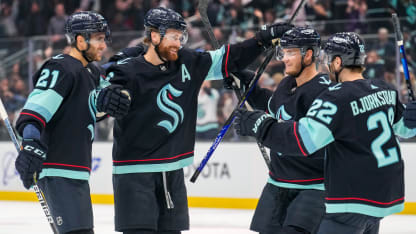
© Christopher Mast/Getty Images
Biggest difference you've seen in the Kraken this season? -- @punmasterrifkin
Exactly what I expected the difference to be -- depth up front.
The Seattle Kraken have a much deeper group of forwards in Year 2 than they had in Year 1 last season, with Oliver Bjorkstrand, acquired in a trade with the Columbus Blue Jackets; Andre Burakovsky, a free agent who signed a five-year contract; and Matty Beniers, who played 10 games at the end of last season but now is a full-time No. 3 center.
Burakovsky, a Stanley Cup champion in 2018 with the Washington Capitals and last season with the Colorado Avalanche, leads Seattle with 14 points (four goals, 10 assists) in 16 games. Beniers is tied with forward Jared McCann for the Kraken lead with five goals. Bjorkstrand hasn't had puck luck for goals yet, scoring one on a Seattle-high 52 shots (1.9 percent shooting percentage) but he has eight assists.
Bjorkstrand and Burakovsky are on the top line with Alex Wennberg. Beniers is centering Jaden Schwartz and Jordan Eberle on a middle-six line. It's hard to say that's a second line or a third line because the other middle-six line is Yanni Gourde between Brandon Tanev and McCann. Eight of the top nine forwards play at least 15 minutes per game; McCann is at 14:41. The Kraken use their fourth line about 8-9 minutes per game at even strength. They don't have a forward with more than five goals, but they have seven players with at least four and 13 with at least one.
The scoring by committee has been working as the Kraken are averaging 3.25 goals per game, 14th in the NHL entering Tuesday; they were tied for 28th with 2.60 goals per game last season. They are 11th on the power play this season at 23.6 percent; they were 29th at 14.6 percent last season.
There also is a resiliency the Kraken have shown that we didn't see much of last season. I'm guessing a lot of that has to do with team chemistry, building together, growing. It's hard to do that when you're thrown together for one season. But now it seems different. The Kraken are 5-1-1 in games when they have been outshot. They're scoring the first goal more often, eight times in 16 games this season (6-1-1 in those games), after doing it 31 times in 82 games last season.
But Seattle has lost its past two games (0-1-1) after winning five straight, including giving up a game-tying power-play goal with six seconds remaining in regulation and losing 3-2 in overtime against the Winnipeg Jets on Sunday. The Kraken have home games against the New York Rangers on Thursday and the Los Angeles Kings on Saturday. That's two teams that made the Stanley Cup Playoffs last season. To be a good team you've got to beat the good teams and stop losing streaks before they get out of control. It's a big week for the Kraken.
SEA@CHI: Burakovsky scores in 1st period
The Devils are legit … tell me I'm right. -- @AnthonyRomeo1
It's looking like you could be right, but forgive me for needing more time to get a proper read on the New Jersey Devils even though they've won 10 in a row following a 5-1 victory at the Montreal Canadiens on Tuesday. The Devils have made the playoffs once in the past 10 seasons; they have not earned the benefit of the doubt. But what they have earned is high praise for how they've played this season so far, which is why this week I have them
No. 2 in my Super 16 rankings
. For starters, they've beaten some good teams, including the New York Islanders, Colorado Avalanche, Edmonton Oilers and Calgary Flames (twice). They're one of the fastest teams I've seen in how they skate, how they move the puck and how quickly they can make a play. And they're deep. They roll four lines and all four come with that same kind of speed. I can talk all day about the skill that forwards Jesper Bratt and Jack Hughes have, how well they play together and read off each other, but the fact that center Nico Hischier is healthy is one of the biggest reasons for the Devils' success. You see how important he is as a top two-way center who is as valuable in the defensive zone as he is in the offensive zone. He can be for the Devils what Aleksander Barkov is for the Florida Panthers, a threat all over the ice.
We also can't overlook how the Devils defense has come together. A healthy Dougie Hamilton and the addition of John Marino, acquired in a trade from the Pittsburgh Penguins during the offseason, has made a world of difference. With Hamilton, Marino and Damon Severson, the Devils are as good on the right side of the blue line as any team in the NHL. All are mobile, puck-moving defensemen. It also allows Jonas Siegenthaler (6-foot-2, 218 pounds), Ryan Graves (6-5, 220) and Brendan Smith (6-2, 200), who make up the left side of the defense, to play to their strengths. They're all big, physical and mobile too. This unit is a big reason why the Devils were allowing an NHL-low 24.4 shots on goal per game entering Tuesday. And that's a big reason why their goaltending has held up well too.
But as good as the Devils have been, they do not have a track record of success that we can lean on. They look legit. They look like a playoff team; they're certainly playing like one. But let's reconvene on this in a few weeks and then I'll have a more definitive answer.
Are there any top teams right now that you see eventually falling out of a playoff position? -- @TrishTheMiddle
The Kraken (8-5-3) are one. They're third in points and second in points percentage in the Pacific Division, but as much as I like their forward depth, as mentioned above, they still lack a gamebreaker and I don't trust their defense or goaltending enough to think they will be able to hang in long enough. They will struggle to win low-scoring games, which is what they will be in as the season goes on. The Edmonton Oilers (9-8-0) are right behind the Kraken and will pass them. The Calgary Flames (7-6-2) also are starting to play better with wins in their past two games after they lost seven straight (0-5-2). Let's see where the Flames are after their six-game road trip up and down the East Coast that starts at the Tampa Bay Lightning on Thursday. They need to come away with more than six of the available 12 points. Losing seven straight left them less room for error on the trip.
I'm still not sold on the Winnipeg Jets (9-4-1), who play 20 games in 37 days starting against the Anaheim Ducks on Thursday. They've played 14 games in 34 days so far. And they've played well enough to stay near the top of the Central Division, but that's with Connor Hellebuyck holding up his end with a 2.08 goals-against average and .935 save percentage, starting 11 of Winnipeg's 14 games. The Jets will need David Rittich to start more in this stretch before Christmas, and so far he has a 2.73 GAA and .890 save percentage in three games. Let's see where the Jets are at Christmas before anointing them as a legitimate playoff team this season.
Do you feel like the NHL is willing to sustain Mullett Arena for three years if the Coyotes aren't doing well enough to get fans to the arena? Or what if attendance falls to under 3,000 a game? Basically, when does Gary Bettman take the Coyotes to Houston? -- @NyInLvr84
The NHL clearly is willing to have the Coyotes play at Mullett Arena for at least three seasons because that's the agreement the team and Arizona State University made; there is an option for a fourth season. That agreement for the Coyotes to play in the 5,000-seat on-campus venue was made with the blessing and consent of the NHL because the League knows that the Coyotes can be a profitable, sustainable, successful franchise for years if they're able to build a new arena in the East Valley of the Greater Phoenix Area. It's a top-10 sports market in the United States and the bulk of the Coyotes' fan base is in the East Valley, which is why the goal is to build a new arena and entertainment district in Tempe, about a mile down the road from Mullett Arena.
The Coyotes will know more about that in the coming days, weeks and months, with the hope that plans could be finalized and shovels get in the ground as soon as possible. It could take 24-30 months to build the arena in Tempe, Coyotes president Xavier Gutierrez said, which means three seasons at Mullett Arena is pretty much a lock if approved. Of course, if the Coyotes do not get approved for a new arena, the NHL and the team will have to reevaluate the entire situation and the potential for relocation again would come up. But that's the worst-case scenario, because if the arena deal gets approved and shovels go in the ground, the Coyotes will stay in Mullett Arena until they move into their new building. And it should, or at least could, happen at the same time when they are out of the rebuild and becoming a potential Stanley Cup contender.
---
Listen: New episode of NHL @TheRink
